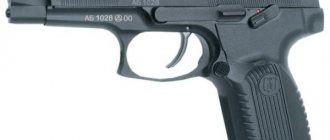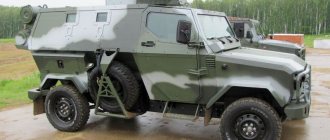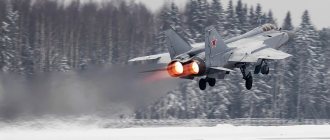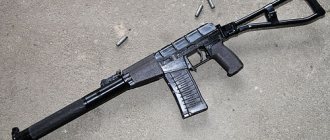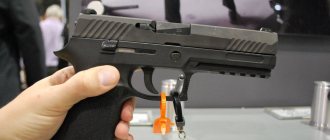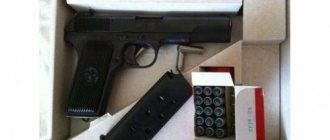History of creation
One of the variants of the “NKVD Finnish”.
, 1930s. In the early to mid-1930s, legislation regarding the circulation of bladed weapons was tightened in the RSFSR; a direct ban on the manufacture, storage, sale and carrying of Finnish knives appeared in the Criminal Code. At the same time, NKVD employees have been receiving, as a special tool, since 1935 a Finnish knife (in some documents a “Norwegian” or “Swedish type knife”), manufactured in several varieties (formerly a factory of the industrialist Kondratov) in the village of Vacha, Nizhny Novgorod region. The basis of the “NKVD knife” was a copy of a Swedish knife produced by P. Holmberg, which was banned as a “Finnish knife.” The knife was characterized by either a straight spine or a spine with a characteristic bevel - “pike”, fullers, and a Finnish type of handle head. A distinctive feature from the Finnish puukko was the developed curved guard, often S-shaped. An unsharpened heel was left on the blade in front of the guard, so that in some grips the index finger could be transferred to the blade. The handle was made of carbolite. The knife was not officially in service, but was issued as clothing allowance. From the 1930s to the end of the 1970s, he completed at least 6 large orders for similar knives.
The Soviet-Finnish War revealed shortcomings in the Red Army's armament. Among other conclusions, in 1940 the models of authorized edged weapons were revised, in particular, a new army knife was adopted for service.
The alleged prototypes of the Soviet army knife are:
- Finnish uniform bayonet-knife of the 1919 model, designed by the artist Akseli Gallen-Kallela and produced by Fiskars - an eclectic model combining a blade with a lower spine line, fullers and a developed heel, a large S-shaped guard, a saber handle with a metal back, an all-metal sheath, repeating the curve of the puukko sheath, a large lanyard brush, borrowed from long-bladed weapons;
- Finnish scout knives (partiopuukko) - knives designed for boy scout organizations in different countries, with clear signs of American traditions - a double-sided (less often one-sided) guard stop, a blade with a predominantly beveled spine, a narrow or wide fuller. Scout models, purchased with personal funds, enjoyed some popularity among soldiers of the regular Finnish army and representatives of volunteer organizations.
None of the models can be called the direct ancestor of the HP-40, although all elements of the knife, design and manufacturing technology are easily recognizable in the prototypes.
Methods of knife fighting that were used in intelligence
You should not believe various sources that claim that the scouts were unsurpassed masters of knife fighting. In reconnaissance, a knife could only be used for a surprise attack and killing an unwary enemy, so scouts were trained only in two knife grips and several standard strikes.
- The usual straight grip, when the hand tightly grips the handle, holding the knife with the blade facing up. From this position it was possible to deliver powerful blows to the opponent’s stomach or ribs. The disadvantages of this grip were excessive stiffness of the hand with the knife and lack of speed;
- The reverse grip was most often used by scouts. Striking from top to bottom, the scout covered the enemy’s mouth with his other hand so that he would not have time to raise the alarm.
Characteristics
| Characteristics of a 1940 model army knife | |
| Total length of knife, mm | 263 |
| Blade length, mm | 152 |
| Maximum blade width, mm | 22 |
| Maximum butt thickness, mm | 2,6 |
| Blade material | Steel U7 |
| Handle material | Tree |
| Method of attaching the blade to the handle | Mounted through installation with riveting of the shank |
The blade has a beveled spine (“pike”, clip-point), the slopes occupy about half the width of the blade, and there is a pronounced heel in front of the guard for moving the index finger onto the blade. The most characteristic feature of the scout knife is the S-shaped crosshair of the guard, which has an unconventional bend: on the side of the blade, the guard stop is bent not towards the handle, but vice versa towards the blade. This unusual “inverted” guard is due solely to the combat orientation of the knife: the main grips were considered to be straight inverted with the blade directed upward (for bottom-up strikes to the abdomen and hypochondrium), or reverse (for top-down strikes to the neck area). In both grips, the knife lies in the hand “upside down” relative to the usual traditional position of the knife, therefore the guard received a corresponding bend. The handle and scabbard were made of wood and painted black (to avoid unmasking during night operations), but the blade was not blued or coated. It was recommended to carry the knife on the waist belt on the left side at an angle of 30°, with the handle to the right.
Knife manufacturers and product features
There are several popular manufacturers who are developing the Cherry knife. Although the weapons are approximately the same, each has its own characteristics and distinctive characteristics.
A&R
The “Cherry” knife from AiR is made of 95×18 stainless steel, high-alloy. Therefore, the hardness of its blade is 58-59 HRC. The shape of the blade and handle are classic for this type of weapon. Its total length is 266 mm, and the working part is 150 mm. The handle material is quartoprene, and it is green in color and grooved. The thickness of the butt is 2.4 mm. These parameters make the product available to everyone without a permit for edged weapons. Its minimum price is 3.8 thousand rubles.
Knife “Cherry” from Air
Zlatoust
The product from the city of Zlatoust from the Zlatko company is distinguished by its large dimensions:
- blade – 160 mm,
- its width is 24 mm,
- total length – 280 mm,
- The maximum thickness of the butt is 2.4 mm.
It is forged from steel grade 100x13, that is, it has a sharp blade with a hardness of 56-58 HRC, which retains its sharpness for a long time and is not afraid of water and aggressive chemicals. Hence the cost of the gun - from 4.7 thousand rubles. It also does not belong to the category of edged weapons.
Watch in this video a review of the “Cherry” knife from the Zlatoust company:
Knox
The Knox company has created a product with different proportions than classic weapons:
- the blade has a length of 147 cm;
- its thickness is 2.3 mm;
- total size – 260 mm.
Knife "Cherry" from Knox
The handle of the product is black, plastic. The blade steel grade is Japanese AUS-8, which allows you to keep the blade sharp for up to 3 months of active use. In addition, it is quite durable. Disadvantage: it rusts easily from water. Therefore, the price is modest - from 2 thousand rubles. on the company's official website.
Russian damask steel
The Russian Bulat company has several products called HP 43:
- Collapsible with a blade made of U8 steel. It has standard dimensions: the cutting part is 152 mm, the total length is 262 mm, the thickness of the black plastic handle is 30 mm. The quality of the steel makes the tool sharp, holds an edge for a long time and is durable under any type of load. Therefore, its price is 7 thousand rubles.
- Non-separable, with a 65×13 steel blade and a green handle. The dimensions of the component parts of the product are the same as the previous one. But the blade material is cheaper, the quality is slightly lower, so the price is 6 thousand rubles.
- Collapsible with Damascus steel blade. The numerical parameters of this tool are the same as the previous ones. Externally, it differs only in the green handle, but it is also made of plastic. Cost up to 8.2 thousand rubles. increases the quality of blade steel. It is sharper since the hardness of the material is 60-64 HRC.
- Non-separable with a blade made of ELMAX powder steel with a hardness of 60-64 HRC, a green plastic handle. Its dimensions correspond to previous products. But powder steel gives the tool higher strength, wear resistance and corrosion resistance. Therefore, it costs 13.2 thousand rubles.
Knife “Cherry” from Russian Bulat, collapsible model
With hornbeam handle
The weapon, for which a hornbeam was used in the manufacture of the handle, is produced by the AiR company from Zlatoust. The product has traditional dimensions and proportions of parts; the blade is made of 100×13 steel. The pommel of the handle is metal, but the handle itself is black. The cost of such a knife is 5.5 thousand rubles.
There is also a cheaper product with a handle made of carved hornbeam from a lesser known one. Its blade is only 155 mm and is made of 65G steel. The characteristics of the material are such that the knife is easily damaged under impact load. But since the blade is small, this drawback does not appear so much. Therefore, the price of the product is 2.6 thousand rubles.
Production
Option of an army knife
The production of HP-40 was launched in the village of Vacha and at the Zlatoust Tool Plant No. 259 named after. V. I. Lenin (ZiK). The vast majority of the total number of army knives were produced in Zlatoust. Peak production during wartime occurred in 1942-1943.
In 1942, the Zlatoust plant produced military knives: 261,000 pieces, in 1943 - 388,000 pieces (of which in the first half of the year - 271,000, in the second - 117,000 pieces).
In addition to serial factory production, the practice of ordering knives from handicraft enterprises and manufacturing them in front-line workshops was widespread. In this regard, numerous types of knives are known that outwardly resemble the standard army knife of the 1940 model, but differ in design and the materials used.
Handicraft modifications and decorations of the statutory knife were also often made. Particularly popular was the replacement of a solid wooden handle with a composite one made of different materials, for example, plexiglass.
Currently, an exact copy of the legendary knife is produced by various knife manufacturers.
Where is the truth about the knife “Cherry” HP 43
According to the official version, the Cherry knife NR 43 was produced by the ZIK plant in Zlatoust. But it is clear that there are no documents at the enterprise that weapons were actually produced there. Additionally, the plastic used for the handle was rare in 1943. It can only be seen on general or award weapons. And they worked with the material manually, which made serial production of the HP 43 in 1943 unrealistic.
But there is documented information about how during the war the ZIK was designing a new type of army knife. The models were indeed made, but in small quantities, they did not reach us. But it most definitely was not the popular HP 43.
Application
Award (so-called "general's") army knife, Zlatoust Tool Factory, 1942-1944
The adoption of the 1940 model knife into service was caused by the appearance in the troops of relatively short samples of small automatic weapons (primarily submachine guns), which did not have attaching the bayonet to the barrel. The army knife was issued to submachine gunners of the Red Army, which is why the knife is sometimes called the “submachine gunner’s knife.”
Techniques of working with a “short Finnish or Norwegian knife” were added to the Sambo combat system by V.P. Volkov in 1940. By 1941, knife operations were included in the “Guide to Preparation for Hand-to-Hand Combat of the Red Army.” The richest and most developed system for using combat knives was the close combat system developed by N. N. Simkin and the Moscow Institute of Physical Education, published in the brochure “Close Combat” (M.: “Physical Culture and Sport”, 1944).
The knife, like firearms, was entered in the Red Army soldier’s book.
The scout knife and its varieties and copies often served as gift and award weapons; corresponding inscriptions were engraved on the blade.
The scout knife was a successful and quite modern weapon for its time; numerous legends are associated with it, exaggerating its fighting qualities.
"Black knives"
In 1943, the entire composition of the Ural Volunteer Tank Corps, equipped with weapons and equipment made with contributions from the working people of the Sverdlovsk, Chelyabinsk and Molotov (Perm) regions, from private to commander, the workers of the Zlatoust Tool Factory, as a gift for all fellow Uralians - soldiers of the new corps, made " Finnish-type knives" with a black ebonite handle, sheath and metal parts of the device. According to the description, these were actually military knives of the 1940 model. German intelligence officers immediately drew attention to the non-standard edged weapons of the tankers, and the Ural Tank Corps began to be called the “Schwarzmesser Division” - “Black Knives Division”. The famous "Schwarzmesser" knife is a legend of the Great Patriotic War. The black knives of the Urals were on display in many local history museums (from school to regional), and were sung in songs. Legends tell about the special quality and super properties of “black knives”.
What is a scout knife for?
The most important priority of bladed weapons has always been that they do not make any noise, unlike other types of weapons, even with a silencer. The main task that a scout performs is to neutralize soldiers guarding various objects. At close range, it will not be difficult for an experienced military man to neutralize the enemy. In this case, special knives will become an excellent tool that will not attract attention to itself.
Another undeniable quality of this item is speed. According to the military, when conducting close combat at a distance of less than three meters, firearms are inferior to knives in terms of reaction speed.
There are several explanations for this. Before shooting, small arms should be removed from the holster and prepared for firing. While the scout always holds the knife in his hand, which does not interfere with movement.
The next indisputable quality that the knife has is its small size. It has a small weight and dimensions, thanks to which this indispensable item for the military is not visible under their clothing.
Another advantage of a knife during reconnaissance and in battle will be helping a wounded warrior. With a knife you can not only cut things on the victim, but also perform a number of simple surgical operations, for example, opening an abscess, when delay can negatively affect not only health, but also life.
In peacetime, scout knives will also become indispensable on hikes, when you need to set up a camp, collect brushwood and branches for a fire. If suddenly a person gets into a car accident and needs to get out of it, then with such a powerful knife it will not be difficult to cut strong seat belts.
Subsequent modifications
Scout knife "Cherry" model 1943.
Polish assault knife model 1955. Based on the 1940 model army knife, the 1943 model “Cherry” reconnaissance knife was created, featuring a plastic symmetrical handle.
In the 1950s, the army knife served as the basis for the development of a bayonet for the experimental Korobov assault rifle.
In Poland, on the basis of the Soviet army knife of the 1940 model, an assault knife of the 1955 model (Polish nóż szturmowy wz.55) was created, which was distinguished by fastening the blade to the handle with two rivets and a metal sheath.
The Yugoslav combat knife of the 1951 model (M1951) was distinguished by a handle that was symmetrical on the back and belly sides, with deep grooves applied to the side surfaces to prevent slipping in the palm. The blade was slightly thicker than the Soviet prototype. The knife was used with the M56 assault rifle before the introduction of the bayonet.
In Czechoslovakia, the Mikov company produced several versions of the V07 combat knife (Útočný nůž vz. V07), which was used in the Czechoslovak army from the 1950s until 1975. The knife differed from the Soviet prototype in a slightly more “upturned” shape of the bevel of the butt, a straight guard and a flatter handle. The knife was worn in its original leather sheath.
Scout Shooting Knives
NRS-2 (
Reconnaissance Knife
S
firing)
the
Soviet Army, USSR Armed Forces
. As a result of experimental developments in the 1960s, two samples of firearms knives were adopted into service with the Soviet Army of the USSR Armed Forces, the handle of which housed a short barrel and a trigger mechanism. Shooting was carried out in the “blade to yourself” position.
NRS (special reconnaissance knife, GRAU Index - 6P25) was developed for the silent SP-3 cartridge, 7.62 mm caliber at TsNIITochMash back in the 60s, had a PS bullet from a 7.62 mm machine gun cartridge of the 1943 model, and also housed in the case between the bullet and the powder charge there is a telescopic piston-pusher. After the shot, the piston, having transferred the necessary energy to the bullet, slowed down on the bevels of the cartridge case, thereby cutting off the powder gases and not creating sound or flame when fired. The NRS knife has a green plastic handle, a metal guard, a straight blade 160 mm long and 30 mm wide, with a “pike” (bevel of the butt) and a saw cut on the butt.
The NRS-2 knife (GRAU Index - 6P32) differs from the NRS in the spear-shaped blade shape and the firing mechanism chambered for the SP-4 silent firing cartridge.
The knives are intended for reconnaissance units of the GRU General Staff special forces, airborne troops and marines.
Modern household samples
The hunting knife, produced in the USSR in the 1980s, is identical to the army knife in size and design.
The 1940 model army knife is currently a commercially attractive brand, serving as the basis for a large number of modern knives, including:
- Knife “Field”, Soyuzspecial equipment (SSO, Special equipment)
- Knife NR-2000 (Scout Knife 2000), LLC ZSN SARO, Vorsma
- Knife “Gyurza”, LLC ZSN SARO, Vorsma
- Knife “Special Forces” A. Titov, Vorsma
- Knife “Penal Battalion”, A&R, Zlatoust
- Knife “Taran”, OOO PP “Kizlyar”
- Knife “NR-40”, Kashulin’s knife-forging workshop, Pavlovo
- Knife “Finka NKVD”, Kashulin’s knife-forging workshop, Pavlovo
DIY knife “Cherry”
Do-it-yourself HP 43 is made in several stages:
First, prepare a drawing of the blade and handle on paper
It is important to observe all dimensions, bevel angles, and roundings. The length of the blade shank should correspond to the size of the handle.
Then a blade blank with a shank is cut from a piece of steel of suitable quality
This is done with a grinder, clamping the plate with clamps. To remove the formed burrs, the workpiece is processed on a grinding machine. Next they make descents on the blade. You need to retreat 10-11 mm from the heel, measure half the width of the blade and remove excess metal using a grinder with a grinding attachment. All that remains is to process the slopes with a belt sander, a file and sandpaper. Now the blade should be hardened. This is done in a forge, heating it until it glows yellow if carbon steel is used, and cooling it in oil. Hardening is considered to have been carried out correctly when, after it, the metal does not respond to the effects of a file. The next stage is steel tempering to increase its ductility. That is, the blade is heated to 220-250 degrees, kept there for an hour and allowed to cool slowly. The procedure can be performed using an oven. The workpiece is not removed from there until it cools down. A guard approximately 2-2.5 mm thick is cut out of a steel plate. It's easier to make it oval. The central hole in the guard should match the width of the shank, that is, it goes right through, but does not dangle in it. It is necessary to make a metal frame for the handle, which will separate the guard from the wooden part of the handle. It requires a sheet of steel 10 mm thick so that the wall size is 3 mm. The handle is made from hornbeam, this is the simplest and does not deprive the knife of its originality. It must be solid, not made from component parts, cut out according to a sketch. Inside the black hornbeam block, a drill makes a longitudinal hole corresponding in thickness to the shank. External surfaces are brought into the appropriate form using a machine, file, or grinder. The weapon is being assembled. The guard must be placed on the tang to the base of the blade. Then a fitting is attached to the wooden part of the handle. The blade is attached to the handle by threading its shank through the hole in the fitting. A nut is attached to the narrow tip protruding from the other end of the handle. It should go through its entire depth, but not protrude too much.
You can make a handle for a knife from cherry yourself in the same way as from hornbeam. You need to take a knot that matches the thickness of the blade and mark the center on the cut. Next, a hole is drilled in it, running along the entire length of the workpiece. A shank with a metal handle already attached to it is inserted into it. A nut is screwed onto the tip of the part, looking out from the other side of the wooden piece.
Now the future handle can be given the desired shape. It is clamped in a vice, processed with a file, on a machine, and planed with another knife. The almost finished handle is polished until smooth. All that remains is to soak it in linseed oil, immerse it in it for 2 days and seal it tightly, and then air dry it for the same time.
We recommend reading about the coolest knives known throughout the world. From the article you will learn about the sharpest, most dangerous and beautiful knives, the ranking of the best knives in the world, the highest quality and most popular in Russia.
And here is more information about the types of combat knives.
“Cherry” is a knife with a legend. But it is very difficult to buy a real one, that is, one that is in service with the Russian army; moreover, you will need permission to own it and a lot of money for the acquisition. But it’s easy to get a replica of a weapon, which will be useful in the forest, fishing, at home and will simply become one of the decorations of the collection.
Interesting Facts
- In the book by F. J. Stephens [en] “Fighting knives” (1980), the Soviet army knife of the 1940 model is called the “Armenian combat knife” (German: Armenisches Kampfmesser Modell 1940), and the meaning of the ZiK abbreviation on the manufacturer’s mark is stated assumption that this is “Zlatoust Industry, Caucasus.” [ source not specified 2450 days
]
In fact: “ZiK” (“Zlatoust Tool Factory”) - this was the mark that was placed on the products of Zlatgravyura LLC in the 1930s and 40s.
Literature
- Magazine "Prorez". - 2000. - No. 3.
- Magazine "Knife". - 2005. - No. 8.
- Kulinsky A. N. Russian edged weapons of the 17th—20th centuries. In 2 vols. - St. Petersburg: Atlant, 2001. - ISBN 5-901555-03-1, ISBN 5-901555-05-8, ISBN 5-901555-04-X.
- Maryanko A. A., Mak A. A. Army short blade of the 20th century: on earth, in heaven and at sea. - St. Petersburg: "MAK", 2007. - 400 p. — ISBN 978-5-9900901-1-8.
- Volkov V.P. Basic techniques for working with a short Finnish or Norwegian knife. Self-defense course without weapons "Sambo". Ed. Zobov N. S. and Stankevich A. L. Textbook for NKVD schools. - M., 1940

